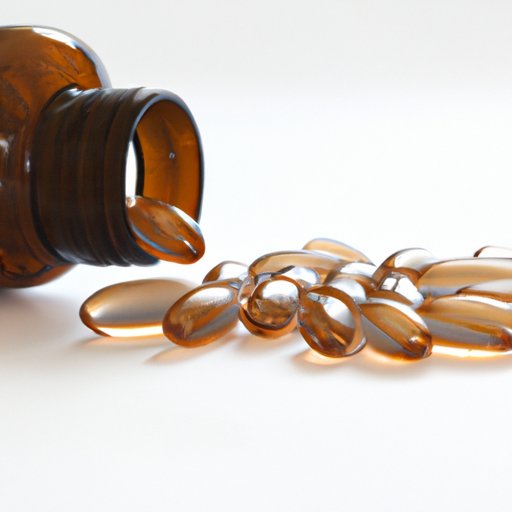
I. Introduction
Iron and vitamin D are both essential nutrients needed for optimal health. While iron is necessary for carrying oxygen throughout the body, vitamin D helps facilitate calcium absorption, promotes immune function, and supports bone health. While these nutrients offer numerous individual benefits, many people wonder if they can take them together for even greater health benefits.
In this article, we’ll explore the benefits, potential side effects, and recommended dosages of taking iron and vitamin D together. We’ll also discuss how these nutrients work in tandem, dietary sources of iron and vitamin D, and scientific research supporting their combined benefits.
II. The Benefits of Taking Iron and Vitamin D Together
Iron and vitamin D are both crucial for optimal health, and taking these nutrients together may offer even greater benefits. One of the major benefits of taking iron and vitamin D together is improved immunity. Studies have found that both iron and vitamin D play an important role in immune function, helping to prevent infection and disease (1).
Iron and vitamin D may also help boost energy levels, reduce inflammation, and promote cognitive function. Additionally, research has found that vitamin D may enhance the absorption and utilization of iron in the body (2).

III. How Iron and Vitamin D Work in Tandem
Iron and vitamin D work synergistically to promote optimal health. One of the reasons for this is that iron is needed for proper absorption and utilization of vitamin D. Without sufficient iron levels, the body may not be able to effectively use vitamin D (3).
Conversely, vitamin D can enhance the absorption and utilization of iron by promoting the production of a protein called ferritin, which helps store iron in the body (4). By working together, iron and vitamin D can help promote strong bones, healthy immune function, and overall well-being.
IV. Potential Side Effects and How to Avoid Them
While taking iron and vitamin D together can offer numerous benefits, it’s important to be aware of potential side effects. One of the most common side effects of taking iron supplements is constipation, while vitamin D supplements can cause nausea, vomiting, or kidney stones (5).
To avoid these side effects, it’s important to take iron and vitamin D supplements as directed and to consult with a healthcare provider before starting a new supplement regimen. Additionally, it’s important to choose high-quality supplements and to take them at the recommended dose and frequency.
V. Recommended Dosages for Various Populations
The recommended daily intake of iron and vitamin D can vary based on age, gender, and health status. In general, adult men and non-pregnant women should aim for an iron intake of 8-18 mg per day, while pregnant or lactating women may need closer to 27 mg per day (6).
For vitamin D, the recommended daily intake is 600-800 IU for adults and children (7). Pregnant and lactating women may need closer to 1000-2000 IU per day (8).
It’s important to note that individual needs may vary, and it’s important to monitor nutrient levels and consult with a healthcare provider before supplementing with iron or vitamin D.
VI. Supplements and Foods that Provide Both Iron and Vitamin D
Dietary sources of iron and vitamin D can help support optimal health, and may be especially beneficial for those who may not be getting enough of these nutrients through their diet alone. Some foods that are rich in both iron and vitamin D include fortified cereals, salmon, tuna, and eggs (9).
In addition to these foods, high-quality supplements can also be helpful for those who need additional iron or vitamin D. When selecting a supplement, it’s important to choose a reputable brand and to select the right dosage based on individual needs and dietary intake.
VII. Taking Iron and Vitamin D Together vs. Separately
Taking iron and vitamin D together can offer numerous benefits, as these nutrients work synergistically to support optimal health. When taken separately, however, some research suggests that the absorption and utilization of these nutrients may not be as efficient (10).
It’s important to note, however, that timing of intake and other factors may impact nutrient absorption. Additionally, some individuals may have unique nutrient needs and may benefit from taking iron or vitamin D separately.
VIII. Scientific Research on the Effects of Taking Iron and Vitamin D Together
There is growing scientific evidence to support the benefits of taking iron and vitamin D together. For example, one study found that taking a combination of iron and vitamin D improved sperm motility and concentration in men with infertility (11).
Another study found that combining iron and vitamin D supplementation may help reduce inflammation and improve cholesterol levels in patients with kidney disease (12).
IX. Conclusion
Taking iron and vitamin D together can offer numerous benefits for overall health and well-being. By working synergistically, these nutrients can help support strong bones, healthy immune function, and optimal energy levels.
While potential side effects may occur, these can often be avoided by taking supplements as directed and consulting with a healthcare provider before starting a new regimen. With the right dosage and intake timing, iron and vitamin D supplementation can be a safe and effective way to support optimal health.
Consider incorporating iron and vitamin D supplements into your daily routine to support optimal health and well-being.





